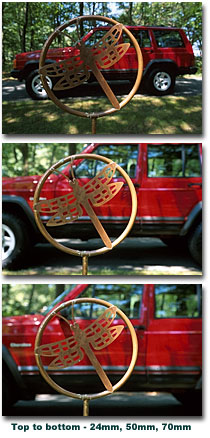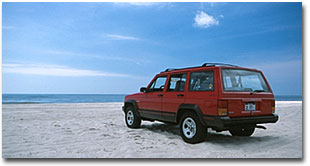|
|

All rights reserved. The automobile commercial showing the little boy standing on the side of the road, whispering this simple phrase as cars go zipping by, always make me smile. A prime example of catchy automotive advertising, it's very difficult to chase the image and the phrase out of your mind once you've seen it. Zoom zoom. In the same sense, the allure of the zoom lens is just as catchy. Today's zoom lenses not only offer the versatility of multiple focal lengths in a single lens, but also greatly improved optical performance compared to models of just a decade ago. A wide variety of zoom lenses are now available for any type of nature photography, for any make of autofocus 35mm SLR camera, and are very effectively marketed by the manufacturers. No doubt about it, zoom lenses are here to stay.
The typical wide-angle to telephoto or "standard zoom" lens is capable of producing three very distinctive looks when used in conjunction with changing position relative to the subject. At the short end of the zoom range, images will take on the classic "wide-angle look" that emphasizes the objects close to the camera, making them appear large in relation to the background. At the long end of the zoom range, images will have the distinctive "telephoto look" of compressed distance between subject and background, making the background appear large in relation to the subject in front of it. And in the middle of the zoom range, around 50mm, the scene will appear "normal," very much like human vision would perceive it. Wide angle, normal and telephoto - three very distinctive "looks" created by changing focal length and relative position to the subject. "Why doesn't this photo look the way I had originally pictured it in my mind?" How many times have you've seen the beginner photographer walk up to a scene, put the camera up to their eye and happily zoom in and out before snapping the shot? There lies the unforeseen trap of the standard zoom - without an understanding of how focal length and distance-to-subject can effect the final image, most novices consider their zoom lens as nothing more than a convenient cropping tool, not as a "bag of primes lenses." In the "old days" when most new SLRs were equipped with a 50mm prime lens, these same novices could be seen moving back and forth, carefully positioning themselves to obtain the correct framing of the subject. In many ways, this valuable lesson in photographic composition has been lost with the advent of the zoom lens. The use (or misuse) of the standard zoom does not relieve the photographer of having to use their feet once they have made the decision of how the scene should be rendered. Instead of arbitrarily placing them self in front of a scene and using the zoom ring as a cropping tool, the photographer should first choose the "look" and then select the zoom setting (focal length) needed to achieve it. Once the appropriate focal length is selected, the photographer should take a position relative to the subject to achieve the desired composition, just as if they were using a single focal length lens. Certainly the zoom ring can be used for minor adjustments in the framing, but avoiding the trap of "zooming" instead of "pre-visualizing and walking" is something all users of the standard zoom should bear in mind.
"The slides I took late in the day on Velvia came out really blurry." Finally, be aware of shutter speed. Since zoom lenses can be up to 3-stops slower than comparable focal length prime lenses, photography in low light can become problematic. While a tripod can be effectively used with slow shutter speeds and stationary subjects, moving subjects are another matter. In those cases, faster film may be the only solution, especially in cases where flash will not be effective or permitted, or when you wish to retain ambient light as the main source. Fixed aperture f/2.8 zoom lenses greatly alleviate this problem, offering faster shutter speeds and often improved image quality, but are usually larger, heavier and more expensive. When using the typical f/3.5 - 5.6 standard zoom, it's always wise to keep a few rolls of high-speed film handy for those low-light photo opportunities. The standard zoom offers the nature photographer convenience and versatility. However, understanding its limitations as well as appreciating its strengths will go a long way in getting the most out of it. "I just bought a new camera, and it has a zoom lens!" Zoom zoom! JE-NPN About the images... Decorative sprinkler sequence - Taken at 24mm, 50mm and 70mm, the camera position was changed to maintain consistent subject size in the frame. Sigma 24-70/2.8 EX Aspherical DG DF at f/5.6 on Fuji Velvia. Three focal lengths and camera-to-subject distances, three distinct perspectives. Line of horizon - Barrel distortion can bend straight lines that are postioned too close to the edge of the frame, producing an "unnatural" look. Like most "consumer zooms," the Canon EF 28-105/3.5-4.5 USM will exhibit higher levels of this type of distortion. Full frame image in width, cropped entirely from the bottom. Jeep on the beach - Composing to keep straight lines away from the edge of the frame minimizes the effects of pincushion and barrel distortion. Canon EF 28-70/2.8L at 28mm, f/5.6 in aperture priority mode, circular polarizer, Fuji Provia 100F. Even though "professional" zoom lenses are usually better corrected for this type of distortion, it's still wise to avoid straight lines near the edge of the frame. Comments on this article? Send them to the editor. |
|
|
 The ability to "zoom" from one focal length to another is certainly a blessing of convenience. Eliminating the need to carry a bag full of prime lenses, a quick turn of the zoom ring is all that it takes to change focal lengths. However, this convenience is also a potential photographic trap with those zooms that cover focal lengths from wide-angle to telephoto - for the uninformed, it's far easier to simply zoom when in many cases, they should be changing their position relative to the subject.
The ability to "zoom" from one focal length to another is certainly a blessing of convenience. Eliminating the need to carry a bag full of prime lenses, a quick turn of the zoom ring is all that it takes to change focal lengths. However, this convenience is also a potential photographic trap with those zooms that cover focal lengths from wide-angle to telephoto - for the uninformed, it's far easier to simply zoom when in many cases, they should be changing their position relative to the subject.
 Fortunately, this type of distortion is easy to detect once you know what to look for. Simply focus on a subject that forms a perfectly straight line and spans the entire frame, such as the edge of an open door, and position it parallel and as close as possible to the edge of the viewfinder frame. The distortion, if present, will be clearly visible. A single test shot will verify if any of the apparent distortion is in the viewfinder optics, which of course will not show up on film. Once you recognize this kind of distortion and become aware of it in your lens, you can adjust your composition to keep straight lines away from the edges of the frame and effectively hide it. Tip - The level of distortion can vary throughout the zoom range - find the zoom setting where it is least noticable and try to use that setting when you must compose a straight line near the edge of the frame.
Fortunately, this type of distortion is easy to detect once you know what to look for. Simply focus on a subject that forms a perfectly straight line and spans the entire frame, such as the edge of an open door, and position it parallel and as close as possible to the edge of the viewfinder frame. The distortion, if present, will be clearly visible. A single test shot will verify if any of the apparent distortion is in the viewfinder optics, which of course will not show up on film. Once you recognize this kind of distortion and become aware of it in your lens, you can adjust your composition to keep straight lines away from the edges of the frame and effectively hide it. Tip - The level of distortion can vary throughout the zoom range - find the zoom setting where it is least noticable and try to use that setting when you must compose a straight line near the edge of the frame.